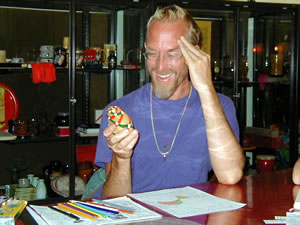Individual Learning Assessments Stories

Several years ago when I was working with adults with developmental disabilities, I had a client who came to my room from another where he was having problems: He constantly left the program room, refused to participate in any activities, and frequently screamed and bit his hand when upset.
On his first day assigned to my room, I noticed a couple of things right away about how he responded to sounds. First, he reacted very strongly to being spoken to harshly or loudly. Second, he liked music and it seemed to mellow him out. Third, he liked to joke around verbally, a LOT! Kinesthetically, he seemed very agile and active, and he seemed to receive physical redirection well, such as a hand on the shoulder. His previous teacher, I knew, happened to have a quite loud and sometimes shrill voice.
We agreed as his staff to not use loud voices to redirect this man, but to use them primarily for joking and conversing with him. If he needed redirection or information, we showed it to him and physically guided him. Inside of two to three weeks he largely stopped leaving the program room, started making small gains in level of participative activity, and his screaming and hand-biting went way down. In the next year, using this response pattern which respected his Thinking Pattern's comfort zone, we emphasized using picture symbol communication with him, which really increased his access to spoken language. Knowing and honoring a person's natural learning and thinking process leads to fuller presence, health, and balance in relationships.
A good friend and I were camping in the North Woods a few years ago. Now, she and I have been aware of our Personal Thinking Patterns for several years and we talk frequently about how they shape our lives and needs. The biggest difference in our patterns is in how we organize information — she does that visually while I organize kinesthetically (in this case by function). Well, as we prepared a campfire feast of several courses after a vigorous day of hiking, my friend systematically spread out all the cooking ingredients on the picnic table at the campsite. She worked on chopping this, I worked on preparing that, and we were both busy and with our thoughts. After a bit the table seemed a bit cluttered to me, so I thought I would tidy up and put away the things that we didn't need out. After about five minutes or so I again noticed that the table was covered with things, including some that I had just put away! I again "tidied up" and went on to tending the fire or whatever the next thing was. And five minutes later, I returned again to find the table surface covered and my friend working on dinner.
What was going on!?! Well, we talked about it, and after brief annoyance on both our parts, we realized what was happening and found it pretty comical: She needed to see everything to be clear on where it was and what was available from our supplies; I needed to have space to move freely and be current with what was on the table in terms of its usefulness at that moment. We had a good laugh over this and now when we cook together we "make space" literally and figuratively for both of us to work in ways that meet these natural ways of thinking.
 |
© 2002 Karen Koshgarian |
This is not a tale of one of my personal clients, but many of my personal clients have fit this pattern. It is the story of a typical school kid who may be told by his teacher to "sit still and pay attention". His mind naturally connects movement with Beta brainwaves, which he experiences as mental clarity, so that sitting still and staring and/or listening actually puts him in a light natural trance state. The reality for this kid is that he pays attention by moving his body and by doing things, not by sitting still. This is a real issue of access for many kids in schools as well as adults who are expected to sit still/only participate verbally/wear uncomfortable clothes in meetings, etc.
Occasionally I have a hard time falling asleep if my mind is busy with the day's activities or if I am emotionally engaged in thinking something through. That is until I applied my awareness of my Thinking Pattern to how I fall asleep! Because I know that paying attention to visual stimulae slow down my brainwaves and put me in a mild trance state, close to that of sleep, the surprising answer for me is to lay with my head on the pillow with my eyes open for a minute or two and just tune in visually to whatever I can see in the dim light of the darkened room. Eyes open put ME right out!!! Your Personal Thinking Pattern™ might be very different — how does it work for you?
